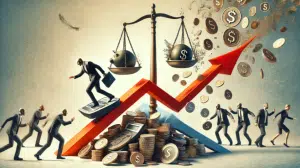The economic landscape is ever-shifting, with various factors influencing the environment of personal finance. Among these, interest rates play a pivotal role, guiding and shaping the credit market, impacting consumers’ access to loans and their ability to manage existing debts.
When rates increase, borrowing becomes more expensive, which can deter individuals from taking on new loans. Conversely, lower rates often encourage spending, prompting a surge in both consumer and business borrowing activities.
Understanding how these fluctuations affect borrowing is crucial for individuals aiming to maintain financial health and stability. As we delve into this topic, we’ll explore the intricate relationship between rising interest rates and the personal credit market, examining how these changes resonate through individuals’ fiscal lives. Staying informed about these trends empowers consumers to make more strategic financial decisions.
The impact of rising interest rates on credit accessibility
When interest rates rise, access to credit often becomes a more challenging endeavor. Financial institutions, adjusting to the higher cost of borrowing from the central bank, pass on this increase to consumers.
Loans become more expensive as the interest charged on credit rises, making prospective borrowers reconsider their financial commitments. Higher rates can discourage people from taking out loans unless absolutely necessary, as the cost of servicing debt becomes a larger part of monthly budgets.
Understanding this dynamic is essential, as it emphasizes the need for strategic financial planning when rates are on an upward trajectory. Moreover, the increased cost of lending can lead financial institutions to tighten credit criteria. Lenders may become more stringent in their assessment processes, requiring higher credit scores or more robust financial backgrounds for loan approvals.
This can be particularly challenging for individuals who are borderline in terms of creditworthiness, as they might find it significantly harder to secure loans. Thus, as interest rates climb, ensuring your personal financial profile is robust becomes even more crucial to navigate these tighter lending environments successfully.
This shift in credit accessibility can also cause ripple effects in other economic areas. With fewer individuals able to obtain loans, sectors reliant on consumer financing, such as real estate and automotive, might witness a downturn in sales.
Businesses could experience decreased consumer spending, thereby needing to adjust their strategies to compensate for reduced demand. Recognizing these broader market implications helps individuals grasp the comprehensive effect that a high interest climate may have on their personal and professional lives.
Effect on existing debts
For individuals holding existing variable-rate loans, rising interest rates can significantly increase the cost of borrowing. As interest rates change, so do the monthly payments on these loans. This can put additional financial pressure on borrowers who may not have accounted for significant increases in their budgets.
Preparing for such adjustments by evaluating existing debts and reconfiguring repayment strategies is vital. Fixed-rate loans, however, remain unaffected in their current terms, providing some stability but, often, with less flexibility for borrowing at lower future rates if economic conditions change.
Another critical dimension is the impact on credit card debts. Credit cards usually have variable interest rates, meaning the interest on any outstanding balances can rise with the national interest rate. This increase can make carrying balances significantly more costly, highlighting the importance of paying off credit card debt quickly or managing it strategically by switching to lower-rate options if available.
Consumer strategies amidst rising rates
In an environment characterized by increasing interest rates, consumers must adopt strategies that mitigate the financial strain these changes may cause. One effective strategy is debt consolidation – combining multiple debts into a single loan with a potentially lower interest rate.
This tactic can simplify repayment processes and reduce overall interest payments, providing some relief against rising rates. Building an emergency fund is another essential strategy. By maintaining a buffer of savings, individuals can avoid high-interest credit in times of unexpected financial difficulty. This safety net can ensure that essential expenses are covered without resorting to costly credit options.
Broader economic implications
The effects of escalating interest rates extend beyond individual borrowing and can have significant ramifications across the broader economic landscape. Consumer behavior shifts as borrowing becomes more costly, leading to reduced spending on large ticket items that often require financing, such as homes and automobiles.
Moreover, higher rates can impact business investments as companies face increased borrowing costs for expansions or operational improvements. Businesses may become more cautious, prioritizing essential expenses and delaying discretionary investments until a more favorable rate environment is present. This caution can stall innovation and expansion, further slowing economic momentum.
Preparing for future rate changes
As individuals and businesses navigate the challenges of rising interest rates, preparing for potential future changes becomes crucial. Staying informed about economic trends can help anticipate rate adjustments and plan accordingly. Regularly reviewing financial documents, consulting financial advisors, and adjusting budgets to accommodate possible rate changes are proactive steps to stay ahead.
Exploring diverse investment opportunities is another method to hedge against rate fluctuations. Diversification can help balance portfolios, offering stability even when interest rates fluctuate. By spreading investments across multiple asset classes, individuals can reduce risk exposure while maximizing potential returns.





